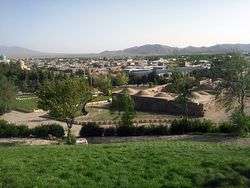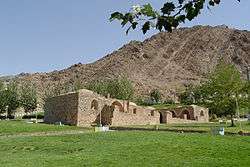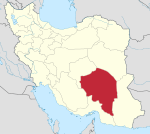Kuhbanan
Kuhbanan (Persian: كوهبنان, also Romanized as Kūhbanān, Koobanan, Kūhbonān, and Kūh Banān; also known as Kūh Baneh)[2] is a city & capital of Kuhbanan County, Kerman Province, Iran. At the 2006 census, its population was 10,112, in 2,623 families.[3]
Kuhbanan كوهبنان | |
|---|---|
City | |
 | |
 Kuhbanan | |
| Coordinates: 31°24′37″N 56°16′57″E | |
| Country | |
| Province | Kerman |
| County | Kuhbanan |
| Bakhsh | Central |
| Population (2016 Census) | |
| • Total | 10,761 [1] |
| Time zone | UTC+3:30 (IRST) |
| • Summer (DST) | UTC+4:30 (IRDT) |

Name
The name Kūhbanān means "pistachio-tree mountain", from the Persian words kūh, meaning "mountain", and banān, which refers to the wild pistachio.[4]
History
Kuhbanan was described by the 10th-century writer al-Muqaddasi as a small town with two gates. The town's jameh mosque was by one of these gates. Outside the walled part of the city was a suburban area, where there were bathhouses and caravanserais. Beyond this suburban area, Kuhbanan was surrounded by farms and orchards that extended as far as the foot of the nearby mountains.[4]
Medieval Kuhbanan was renowned for its production of tutty, an impure oxide of zinc used as a salve for the eyes. As early as the 10th century, al-Muqaddasi listed tutty from Kuhbanan as one of the major exports of Kerman province. He wrote that it formed in finger-like "pipes", which were then purified by being roasted in long furnaces by the same mountainside where the ore was extracted. In the early 1200s, Yaqut al-Hamawi similarly described Kuhbanan, along with the nearby town of Behabad, as a major exporter of tutty. Marco Polo visited Kuhbinan, which he called Cobinan, in the 1300s, and provided a detailed description of the local tutty industry. Around the turn of the 20th century, the British traveler Percy Sykes witnessed the production of tutty in Kuhbanan; the process he described was essentially the same as that used hundreds of years earlier.[4]
References
- https://www.amar.org.ir/english
- Kuhbanan can be found at GEOnet Names Server, at this link, by opening the Advanced Search box, entering "-3072278" in the "Unique Feature Id" form, and clicking on "Search Database".
- "Census of the Islamic Republic of Iran, 1385 (2006)". Islamic Republic of Iran. Archived from the original (Excel) on 2011-11-11.
- Le Strange, Guy (1905). The Lands of the Eastern Caliphate: Mesopotamia, Persia, and Central Asia, from the Moslem Conquest to the Time of Timur. Cambridge: Cambridge University Press. p. 309. OCLC 458169031. Retrieved 2 May 2020.
